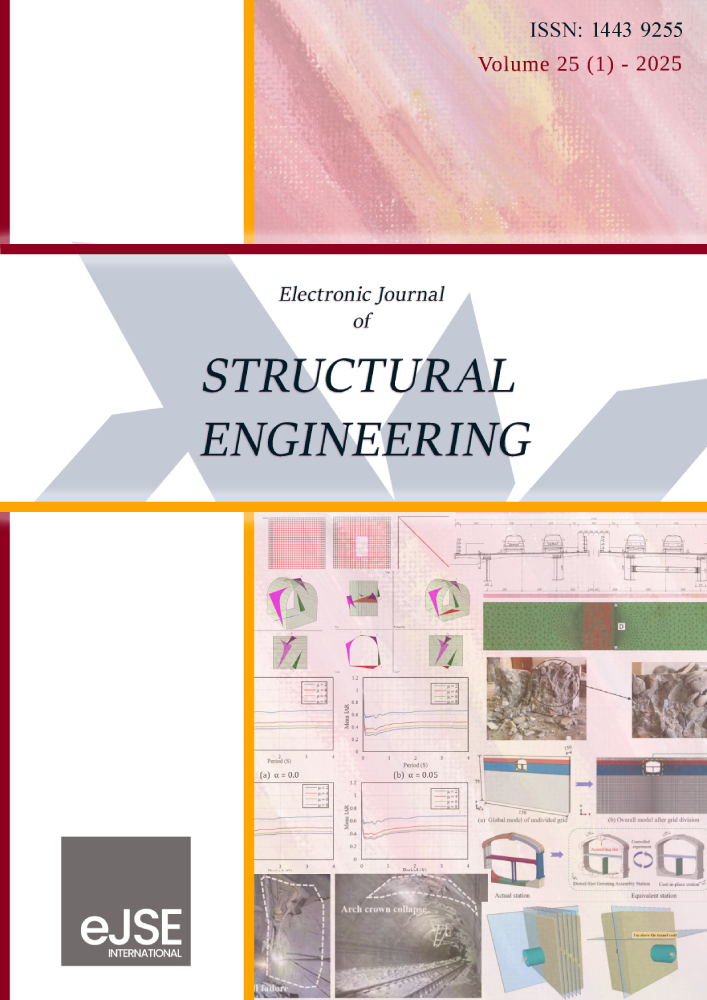Mesoscale numerical study of size effect on concrete fracture characteristics based on FDEM
DOI:
https://doi.org/10.56748/ejse.24667Keywords:
Concrete, Microscopic simulation, Fracture characteristic, FDEM, Size effectAbstract
Fracture characteristics of concrete remains a focal point of current research. Traditional experimental approaches and finite element simulations face limitations in the study of concrete's fracture behavior. The novel combined finite-discrete element method (FDEM) offers pronounced advantages for investigating concrete fracture at the mesoscopic scale. In this paper, utilizing the FDEM approach, a mesoscale concrete model encompassing aggregates, mortar, and the interfacial transition zone was constructed. Three-point bending simulations on concrete beams with precast cracks revealed the mesoscopic fracture processes and characteristics. Results showed that as beam height increases, the fracture energy of the specimens first increases then decreases, and the ductility index decreases. Additionally, as the crack height ratio increases, the beam's fracture energy gradually lowers, while the ductility index initially rises then falls. This study provides insights into beam fracture mechanisms and properties, contributing to the failure analysis of concrete structures at the engineering scale.
Downloads
References
Baktheer, A., E. Martínez-Pañeda, and F. Aldakheel. 2024. “Phase field cohesive zone modeling for fatigue crack propagation in quasi-brittle materials.” Computer Methods in Applied Mechanics and Engineering, 422: 116834.
Bažant, Z. P. 2004. “Probability distribution of energetic-statistical size effect in quasibrittle fracture.” Probabilistic Engineering Mechanics, 19 (4): 307–319.
Bhowmik, S., and S. Ray. 2019. “An experimental approach for characterization of fracture process zone in concrete.” Engineering Fracture Mechanics, 211: 401–419.
Chen, B., H. Yu, J. Zhang, H. Ma, and F. Tian. 2022. “Effects of the embedding of cohesive zone model on the mesoscopic fracture behavior of Concrete: A case study of uniaxial tension and compression tests.” Engineering Failure Analysis, 142: 106709.
Chen, H., R. K. L. Su, A. S.-L. Fok, and B. Yuan. 2020. “An investigation of fracture properties and size effects of concrete using the ESPI technique.” Magazine of Concrete Research, 72 (17): 888–899. ICE Publishing.
Chen, Q., J. Zhang, Z. Wang, T. Zhao, and Z. Wang. 2024. “A review of the interfacial transition zones in concrete: Identification, physical characteristics, and mechanical properties.” Engineering Fracture Mechanics, 300: 109979.
Golewski, G. L. 2023. “The Phenomenon of Cracking in Cement Concretes and Reinforced Concrete Structures: The Mechanism of Cracks Formation, Causes of Their Initiation, Types and Places of Occurrence, and Methods of Detection—A Review.” Buildings, 13 (3): 765. Multidisciplinary Digital Publishing Institute.
Guo, X. H., and R. I. Gilbert. 2000. “The effect of specimen size on the fracture energy and softening function of concrete.” Mat. Struct., 33 (5): 309–316.
Huang, Y., Z. Yang, H. Zhang, and S. Natarajan. 2022. “A phase-field cohesive zone model integrated with cell-based smoothed finite element method for quasi-brittle fracture simulations of concrete at mesoscale.” Computer Methods in Applied Mechanics and Engineering, 396: 115074.
Karihaloo, B. L., H. M. Abdalla, and Q. Z. Xiao. 2003. “Size effect in concrete beams.” Engineering Fracture Mechanics, 70 (7): 979–993.
Li, C., and J. Guo. 2019. “Cracking simulation of asphalt concrete beam specimen using cohesive zone model.” Construction and Building Materials, 214: 49–60.
Liu, F., C. Zhou, B. Wang, Z. Chen, and C. Fan. 2024. “Understanding the interface fracture mechanism by composite BFPMPC mortar and cement concrete bending beam.” Journal of Building Engineering, 95: 110145.
Lu, W. Y., and S. W. Hu. 2015. “Effect of large crack–depth ratio on three-point bending concrete beam with single edge notch.” Materials Research Innovations, 19 (sup8): S8-312-S8-317. Taylor & Francis.
Ma, H., W. Xu, and Y. Li. 2016. “Random aggregate model for mesoscopic structures and mechanical analysis of fully-graded concrete.” Computers & Structures, 177: 103–113.
Malachanne, E., M. Jebli, F. Jamin, E. Garcia-Diaz, and M.-S. El Youssoufi. 2018. “A cohesive zone model for the characterization of adhesion between cement paste and aggregates.” Construction and Building Materials, 193: 64–71.
Omar, Z., S. Sugiman, M. M. Yusoff, and H. Ahmad. 2022. “Predicting the Flexural Behaviour of CFRP-Strengthened Concrete Beam using Combined XFEM and Cohesive Zone Model.” J. Appl. Sci. Eng., 25 (6): 1077–1090. Tamkang University Press.
Skarżyński, Ł., and J. Tejchman. 2021. “Investigations on fracture in reinforced concrete beams in 3-point bending using continuous micro-CT scanning.” Construction and Building Materials, 284: 122796.
Tada, H., P. C. Paris, and G. R. Irwin. 1973. “The stress analysis of cracks.” Handbook, Del Research Corporation, 34 (1973).
Tang, Y., H. Chen, and J. Xiao. 2022. “Size effects on the characteristics of fracture process zone of plain concrete under three-point bending.” Construction and Building Materials, 315: 125725.
Wang, Q., H. Chen, H. Zhang, C. Liu, Y. Zhao, and X. Huang. 2017. “Relationship of deflection and crack mouth opening displacement of concrete beams under the three-point bending.” Yingyong Lixue Xuebao/Chinese Journal of Applied Mechanics, 34 (5): 937–943.
Wang, Q., and Y. Xu. 2024. “Macro-meso cracking inversion modelling of three-point bending concrete beam with random aggregates using cohesive zone model.” Theoretical and Applied Fracture Mechanics, 133: 104566.
Wang, Z., J. Gou, and D. Gao. 2021. “Experimental Study on the Fracture Parameters of Concrete.” Materials, 14 (1): 129. Multidisciplinary Digital Publishing Institute.
Wu, Z., H. Rong, J. Zheng, F. Xu, and W. Dong. 2011. “An experimental investigation on the FPZ properties in concrete using digital image correlation technique.” Engineering Fracture Mechanics, 78 (17): 2978–2990.
Xue, Y., Y. Cheng, Q. Li, K. Wang, W. Xu, and W. Du. 2023. “Research on dynamic failure mechanism of three-point bending beam with joint.” Mechanics of Advanced Materials and Structures, 30 (4): 870–893. Taylor & Francis.
Yankelevsky, D. Z. 2024. “The uniaxial compressive strength of concrete: revisited.” Mater Struct, 57 (6): 144.
Yin, Y., and S. Hu. 2021. “Effects of span-depth ratios on the energy release rate for three-point bending beams.” Engineering Fracture Mechanics, 244: 107567.
Yin, Y., S. Hu, C. Liang, and Y. Sun. 2023. “Crack extension resistance for a general three-point bending concrete beam.” Engineering Fracture Mechanics, 290: 109490.
Yin, Y., Z. Jing, S. Hu, C. Liang, G. Hou, Y. Sun, and Y. Wang. 2024. “Study on crack propagation behaviors of three-point bending concrete beams with small span-depth ratios.” Theoretical and Applied Fracture Mechanics, 133: 104638.
Zhang Ruilin, Huang Feng, Deng Shiling, and Liu Xingchen. 2023. “Simulation of Crack Propagation of Concrete Pure Bending Beam Based on XFEM.” Chinese Quarterly of Mechanics, 44 (1): 193–202.
Zhou, R., and H.-M. Chen. 2019. “Mesoscopic investigation of size effect in notched concrete beams: The role of fracture process zone.” Engineering Fracture Mechanics, 212: 136–152.
Zhou, R., H.-M. Chen, and Y. Lu. 2020. “Mesoscale modelling of concrete under high strain rate tension with a rate-dependent cohesive interface approach.” International Journal of Impact Engineering, 139: 103500.
Zhou, R., Y. Lu, L.-G. Wang, and H.-M. Chen. 2021. “Mesoscale modelling of size effect on the evolution of fracture process zone in concrete.” Engineering Fracture Mechanics, 245: 107559.
Zhu, S., Z. Zhou, and Y. Xiong. 2024. “Mesoscale fracture analysis of three-point bending concrete beams based on cohesive zone model.” Engineering Fracture Mechanics, 296: 109828.
Downloads
Published
How to Cite
Issue
Section
License
Copyright (c) 2025 Yamin Wu, Tuanjie Wang, Junfeng Duan, Lei Song

This work is licensed under a Creative Commons Attribution 4.0 International License.







